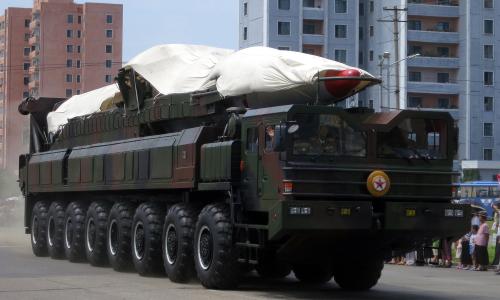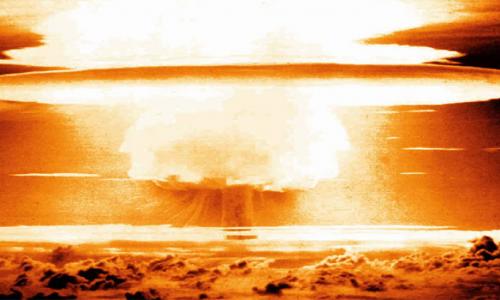Global security expert Dr. Cameron Tracy discusses misconceptions about hypersonic weapons and how they could lead us into another arms race.
In this episode
- Colleen tries to answer the age old question: do hypersonic weapons live up to the hype?
- Cameron explains what these weapons are, and what they mean for global security
- Katy Love brings us part three of our series on fossil fuel company accountability
Timing and cues
Opener (0:00-0:37)
Intro (0:37-2:01)
Interview part 1(2:01-13:03)
Break (13:03-14:26)
Interview part 2 (14:26-22:10)
Segment throw (22:10-22:49)
Ending segment (22:49-27:17)
Outro (27:17-28:30)
Related content
Show credits
Ending segment: Katy Love
Editing: Omari Spears
Additional editing and music: Brian Middleton
Research and writing: Jiayu Liang and Pamela Worth
Executive producer: Rich Hayes Host: Colleen MacDonald
Full transcript
Colleen: Cameron, welcome to the podcast.
Cameron: Thanks so much for having me.
Colleen: I wanna start by defining hypersonic weapons. Can you give me a basic definition?
Cameron: Yeah, so a one-sentence definition for a hypersonic weapon is a missile that flies five times faster than the speed of sound, or more, through earth's atmosphere. Now, the second part of that is really important. Many people think hypersonic, they just think fast. It's a fast missile and that's not really the case. Hypersonic is actually fairly poor in nomenclature here because it doesn't distinguish hypersonic weapons from other existing types of missiles. In fact, the first modern missile, the German V-2, which was developed in the 1940s, flew at just below five times the speed of sound, just below that cutoff for what defines a hypersonic velocity. So, really, what distinguishes a hypersonic missile is that, rather than flying high into outer space before dropping back down to earth, it glides at a fairly low altitude through the atmosphere.
A good way to understand this is by process of analogy. An existing ballistic missile, so an older missile technology, we might think of as being akin to throwing a baseball. So, it's initially accelerated by your arm and then once you let go of the baseball, it flies along a predetermined path to wherever it's going to go. Once you let go of it, you really don't have any control over it. It's just flying like a ballistic missile would. And we all know that if you wanna throw a baseball a long distance, you have to throw it pretty high up.
So, on the other hand, a hypersonic weapon, we might think of as like a paper airplane, so it's accelerated by your arm in the same way, but once you let go of it, it's not just flying along this arching path, it actually glides, so it doesn't have to go as high up. It can just, kind of, fly along the ground for a long distance. And you might imagine, that if you could somehow move the wings a little bit as it flew, it could glide around. It could turn. It could go to a different place than where it was initially heading when you let go of it.
Colleen: Talk to me a little bit about the speed.
Cameron: Yeah so five times the speed of sound, the cutoff for the hypersonic velocity regime, means a few kilometers per second. Not per hour, per second. So, this is, for example, at least five times faster than the fastest currently existing fighter jet. So, really, the only manmade things that travel this quickly are missiles, space shuttles, that sort of thing.
Colleen: Where have they tested them?
Cameron: Yeah, so the U.S. has conducted several test flights mostly between Southern California and the Marshall Islands. There was one attempted test between Alaska and the Marshall Islands. That one failed. In fact, there's been a fairly mixed record. About half of the tests so far haven't made it to their destination as intended, but the other half have. So, distances of several thousand kilometers were used in these test flights.
Colleen: So, what kind of weapons are on these missiles?
Cameron: It depends on the country developing them. So, most of these systems are what we would call dual use, meaning they could be conventional explosives or they could be nuclear warheads. So, it's generally just a matter of the weight that the vehicle can carry and the space available inside it. In most of the systems currently under development, they can carry a great deal of weight. So, in U.S. tests, for example, some of these have carried several hundred kilograms of ballast. This is essentially extra material that you put in to balance it to simulate the mass of the warhead that it might carry in an actual use case, and so that's a few hundred kilograms. Modern nuclear warheads, many of them weigh, again, a few hundred kilograms and there's sufficient space within these missiles to carry those sorts of warheads if it were desired.
Colleen: What are the rules in U.S. governing whether we can put nuclear weapons on these missiles?
Cameron: In the U.S., it's simply a matter of policy. Current US policy is that these will carry only conventional explosives. They won't be used for nuclear weapons. But again, that's not a technical constrain in any way. So, if in the future, the U.S. developed these systems and was interested in using them for delivering nuclear warheads, that's probably something that would be a fairly simple matter of achieving.
Colleen: And are hypersonic weapons a new technology?
Cameron: It's really interesting. They're often seen as the hot new thing in missile technology, but interestingly, the idea is actually pretty old. So, the modern rocket was developed in 1920s and shortly after that in the 1930s, two German engineers, a husband and wife couple, Sänger and Bredt, started proposing putting a glide vehicle, what we would now call a hypersonic glider, on the front of one of these rockets so that rocket could accelerate it to hypersonic velocities and then just like the weapons currently under development, it could glide through the atmosphere.
The first modern ballistic missile, so the first use of a rocket to deliver an explosive warhead, was in the 1940s as I mentioned earlier with this German V-2 missile. And by the 1950s, the U.S. was testing the X-15, so this was a crude rocket-powered aircraft, essentially a missile, but there was a person in it that traveled at hypersonic velocities through the atmosphere, so that's what we might call the first operating hypersonic vehicle.
They weren't widely considered for weapons use until fairly recently. And in fact, historically, they've been seen as having many disadvantages compared to, for example, ballistic missiles, which were developed and that's because hypersonic weapons, since they can glide through the atmosphere rather than flying through outer space for most of the flight like a ballistic missile does, are subject to the effects of drag. So, if you think of sticking your hand out the window of your car, you can really feel the air pushing back on your hand, right? That's going to slow anything that's gliding through the atmosphere. So, if you want your missile to get from point A to point B quickly, you might not want it to be within the atmosphere. You might rather have it in outer space where you're free from that effect of drag, which is how ballistic missiles work.
Colleen: Well, that makes me think of the recent blog posts that you've written where you've, kind of, debunked some of the technical claims that were being made about hypersonic weapons. Can you walk me through a few of those drawbacks?
Cameron: Yeah. So, there are myriad claims about the supposed advantages of hypersonic weapons compared to established missile technologies, those that are currently used. Just to go through a few of those, the most common is that hypersonic weapons are exceptionally fast. Now, this claim isn't really true. In fact, as I mentioned before, they're fired on the same rockets as existing missiles, so many of the hypersonic weapons tested to date in the U.S., for example, are initially launched on rockets that are repurposed from old Peacekeeper intercontinental ballistic missiles. So, they reach the same initial speed because it's accelerated on the same rocket. Now, after that, hypersonics do fly a more direct path to their target. They don't have to go far into outer space before dropping back to earth, but that said, there's also this effect of drag that is unique to hypersonic flight. Long-term flight through the atmosphere means you're experiencing that drag for a long period of time.
So, one thing we've been doing is computational modeling to look at how those two factors, the direct flight path, the effects of drag, balance out to determine the delivery time—how long it takes for a hypersonic weapon to go from point A to point B compared to existing ballistic missiles. And what we find is that ballistic missiles, if fired on a specific trajectory optimized to minimize that delivery time, can reach targets at intercontinental distances faster than a hypersonic weapon could because hypersonic weapons are slowed by the effects of atmospheric drag for such a large portion of their flight.
A second common claim is that hypersonic weapons are invisible or that they can't be seen by existing early warning systems meant to warn of an incoming missile attack. So, this has a grain of truth to it. Radar systems based on the ground do have a hard time seeing hypersonic missiles because hypersonic missiles fly low to the ground, meaning that they don't rise above the horizon until they're within a few hundred kilometers of that radar.
That said countries advanced early warning systems like the United States and Russia, for example, don't rely entirely on ground-based radar. The U.S. and Russia both have space-based early warning systems. Those are satellites with infrared sensors watching the surface of the earth. China is developing such a system as well right now. These look for infrared light given off by hot objects, and in fact, when flying through the atmosphere, hypersonic weapons get extremely hot. They tend to glow giving off a lot of infrared light. So, modeling we've been doing indicates that actually this emission of infrared light from these very hot gliders would be sufficient for existing space-based early warning systems to see them for most of their flight.
Finally, there's this common claim that hypersonic weapons are immune to existing defenses, that they can't be stopped. So, again, there's a grain of truth to this. Hypersonic weapons likely fly under the area in which existing antiballistic missile systems can intercept ballistic missiles. But in a way, that's, of course, the case because a system designed to intercept a ballistic missile is going to fare poorly against a non-ballistic missile. Different systems developed to counter hypersonic weapons specifically might do better at that. Also, at the end of flight, because of the effects of drag, hypersonic weapons tend to be traveling more slowly than existing ballistic missiles, so they could be more vulnerable to missile defenses there. But overall, this is largely irrelevant because existing antimissile defenses fare pretty poorly against existing ballistic missiles fired by technologically advanced nations. It's really hard to knock a ballistic missile out of the air. So, even if a hypersonic weapon were much more difficult to knock out of the air, that might not change anything.
[Break]
Colleen: Cameron, these weapons aren't sounding so hot anymore. They're not as fast because of the drag. They're not really invisible. They get hot and they glow, so you can maybe see them. What is the motivation for developing them and what are we trying to solve?
Cameron: So, interestingly, there are three countries that are most ardently pursuing these weapons right now, the United States, Russian, and China, and each has its own very distinct motivation for developing these weapons in the first place. So, in the U.S., they were initially part of what was called the Conventional Prompt Global Strike Program. This was something started around the early 2000s and the idea was that the U.S. wanted a nonnuclear weapon that it could use anywhere on earth to target nonstate actors, terrorist groups, this sort of thing. And hypersonic gliders were attractive for that purpose because when one is coming in, it doesn't look like a ballistic missile at all. It doesn't look like the missiles that are currently used to carry nuclear weapons and so there's less of a chance of a nation targeted or nearby, a targeted area, thinking that this is a nuclear strike against them. Instead, they would understand, "Oh, that's a different conventionally armed missile," so it would be less likely to accidentally result in nuclear retaliation.
Russia had an entirely different purpose. Their hypersonic weapons are actually nuclear-armed. In 2002, the U.S. withdrew from a treaty with Russia, the Anti-Ballistic Missile Treaty, which limited missile defenses that each country could deploy. Russia wasn't a fan of this, so they were worried that the U.S. might deploy missile defenses that could stop incoming Russian nuclear-armed missiles. As a result, they developed their hypersonic weapons to circumvent any potential missile defense that the U.S. deployed. And so, theirs are explicitly nuclear-armed whereas the U.S. weapons are explicitly conventionally-armed.
Then, there's China where the motivation is much more opaque. They seem to be looking at both conventional and nuclear use cases. One possible motivation there is simple technological prestige. So, a lot of the Chinese work in this area is just published in the open academic literature. And what all of this raises is an interesting question of whether one weapon can really do all of these things. Can it fulfill all of these different purposes? And what that might point to is that this is more of an arms racing dynamic than anything else. It might not matter exactly what the weapon does, but all the great powers have to have it because the other great powers are pursuing it and they don't wanna be left behind. There are also financial incentives. In the U.S. right now, hypersonic weapons development comprises about 3% of all current U.S. defense research and development spending, so there are these incentives to keep that funding flowing.
Colleen: It seems like human nature can easily get us into an arms race. If the country over there is developing something that leaves me vulnerable and so I need to develop something as strong or stronger. How do I answer that question when someone says to me, "But we have to have this weapon because they have it."
Cameron: When talking about the need to develop a new weapon, oftentimes, people will look at the purported advantages of that weapon and not see any downside with that. So, they would say, "The worst case scenario is, okay, you waste some money and you have a weapon that doesn't really do what it was supposed to do, but there's no net negative effect." But actually, there is. So arms racing in it of itself is inherently dangerous. It's been empirically shown that arms races increase the likelihood of conflict, for example, between the countries that are arms racing, so that becomes really dangerous when this is a nuclear or a nuclear-capable system because so much of the global architecture of nuclear security relies on stability, the ideas of mutually-assured destruction and so on, mutual vulnerability. So, anything that upsets that stability is a huge threat because we start bringing in even existing nuclear systems that might not really have anything to do with a hypersonic weapon, but if all of a sudden everyone is concerned about whether their missiles defenses might work, whether they need this new weapon to counter weapons being developed by other countries, then the overall global nuclear risk increases.
There are also issues associated simply with those costs. So, every billion dollars per year that is spent on developing hypersonic weapons isn't spent on much needed things like pandemic response capabilities, which is also a very important part of U.S. security.
Colleen: Are there any arms control agreements that prevent the U.S. or others from using hypersonic weapons?
Cameron: There aren't right now, but there could be and should be. With New START soon up for renewal or renegotiation or expiry, hopefully renewal, this might be a good opportunity to make sure that the newest class of missile, hypersonic missiles, are clearly and explicitly integrated into that agreement and subject to those same limitations based on fact that they are capable of carrying nuclear weapons between the United States and Russia and this New START agreement forms the bedrock of U.S.-Russian nuclear arms control.
Colleen: So, what do you see as the path that the U.S. should take?
Cameron: So, the U.S. would be wise to maybe take a step back and think about why the U.S. is developing these weapons and whether they actually fill any particular role that needs to be filled. To date, there hasn't really been a clear mission for these weapons articulated. So, early on, there was this conventional Prompt Global Strike idea, but since the 2000s, the focus has just shifted less to use against terrorists and nonstate actors and currently there isn't really a clear rationale for what these weapons are meant to do. That said, they are clearly doing something. They're driving an arms race between the United States, Russia, and China. They're costing billions of dollars per year for the U.S. that could go to other things that actually enhance the security of the U.S. populous. So, what there's really a need for here is better technical assessment to look at, well, what role could these weapons actually play? What do they actually do compared to technologies that already exist and which we've already invested a great deal of money and time into? So, there is a key role for legislative oversight. It's the job of congress to make sure that funding being directed to these weapons is directed efficiently and effectively towards things that make Americans or the world safer. So that's a place where independent experts like USC can really help because there's this need for information rooted not in these overblown claims of the revolutionary nature of these weapons but in rigorous scientific analysis of how they would actually perform once developed.
Colleen: Well, Cameron, thanks for joining me on the podcast.
Cameron: Oh, great. Thanks so much for having me.



